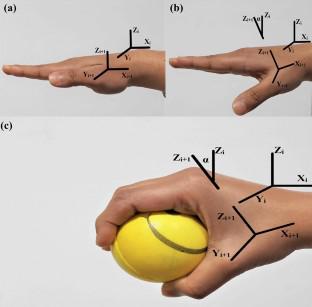International Journal of Intelligent Robotics and Applications ( IF 2.1 ) Pub Date : 2022-06-21 , DOI: 10.1007/s41315-022-00244-0 Abhijit Boruah , Nayan M. Kakoty , Tazid Ali , M. B. Malarvili

|
The potential of humans to recognize known objects while grasping, without the help of vision, is an exciting supposition to the robotics community. With a focus on reproducing such a natural aptitude in prosthetic hands, this paper reports a kinematic approach to exploring the human hand’s object recognition functionality during a grasp. Finger kinematics vary while grasping objects of different shapes and sizes. The authors emphasized learning the variations while grasping different objects through a forward kinematics model of the human hand. Finger joint kinematics for objects of two specific shape categories: spherical and cylindrical, were recorded during grasping experiments using a customized data glove to deduce the fingertip coordinates. An algorithm has been developed to derive novel three-dimensional grasp polyhedrons from fingertip coordinates. Areas of these polyhedrons and finger kinematics have been used as features to train classification algorithms. Comparing the recognition results using only finger kinematics as features revealed that the inclusion of the shape primitives increases the accuracies of the classifiers by 2–6% while recognizing the objects. This work analytically confirms that finger kinematics and the object’s shape primitives are vital information for visionless object recognition.
中文翻译:

使用基于外壳的探索过程中的特征在抓握上进行面向形状的对象识别
人类在没有视觉帮助的情况下在抓取的同时识别已知物体的潜力,对于机器人界来说是一个令人兴奋的假设。本文着重于在假手中再现这种自然能力,报告了一种运动学方法来探索人手在抓握过程中的物体识别功能。手指运动学在抓取不同形状和大小的物体时会发生变化。作者强调通过人手的正向运动学模型在掌握不同物体的同时学习变化。在使用定制数据手套推断指尖坐标的抓取实验期间,记录了两种特定形状类别的物体的手指关节运动学:球形和圆柱形。已经开发了一种算法来从指尖坐标推导出新的三维抓取多面体。这些多面体和手指运动学的区域已被用作训练分类算法的特征。比较仅使用手指运动学作为特征的识别结果表明,形状基元的包含在识别物体时将分类器的准确度提高了 2-6%。这项工作分析证实手指运动学和物体的形状基元是无视觉物体识别的重要信息。比较仅使用手指运动学作为特征的识别结果表明,形状基元的包含在识别物体时将分类器的准确度提高了 2-6%。这项工作分析证实手指运动学和物体的形状基元是无视觉物体识别的重要信息。比较仅使用手指运动学作为特征的识别结果表明,形状基元的包含在识别物体时将分类器的准确度提高了 2-6%。这项工作分析证实手指运动学和物体的形状基元是无视觉物体识别的重要信息。




















































 京公网安备 11010802027423号
京公网安备 11010802027423号